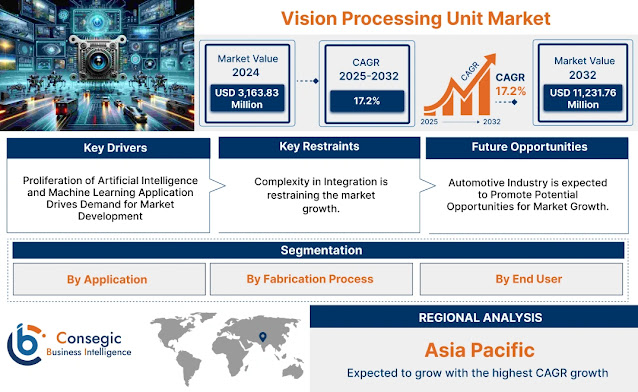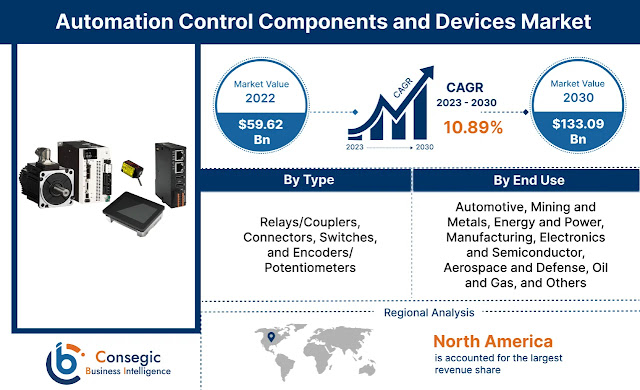Vision Processing Unit Market: Powering the Future of Intelligent Imaging
The Vision Processing Unit (VPU) Market represents a pivotal force in the convergence of artificial intelligence, imaging, and edge computing. VPUs are specialized microprocessors optimized for handling complex visual data with high efficiency and low power consumption. As industries increasingly rely on machine vision, real-time object detection, and AI-driven decision-making, VPUs are stepping into a critical role.
From autonomous vehicles and surveillance systems to smartphones and healthcare imaging, VPUs are transforming how machines interpret and act on visual data. Their importance is rapidly rising as demand for fast, intelligent, and low-latency visual processing becomes standard across industrial and consumer applications.
Market Size and Growth Potential
In 2024, the global Vision Processing Unit Market is valued at USD 3,163.83 million, projected to grow to USD 3,650.36 million in 2025. Looking ahead, the market is expected to reach USD 11,231.76 million by 2032, expanding at a CAGR of 17.2% from 2025 to 2032.
This sustained high-growth trajectory signifies more than just market expansion—it reflects a fundamental shift in how vision technology is deployed. Increasing investments in edge AI, real-time analytics, and connected ecosystems are driving the need for localized, efficient visual computation. VPUs are uniquely positioned to meet this need, enabling faster decision-making at the edge, reducing latency, and lowering reliance on cloud infrastructure.
2. Key Market Segments
The Vision Processing Unit Market can be segmented by fabrication process, application, and end-user sectors:
By Fabrication Process
-
≤16 nm
-
16–28 nm
By Application
-
ADAS (Advanced Driver-Assistance Systems)
-
Smart Phones
-
Cameras
-
Surveillance Systems
-
Medical Imaging Technologies
-
HVAC Systems
-
Smart Home
-
Others
By End-User
-
Automotive
-
Security and Surveillance
-
Healthcare
-
Consumer Electronics
-
Others
Segment Summary:
This segmentation provides clarity on where VPUs are adding value—from real-time object detection in ADAS and smart home devices to enhanced image recognition in healthcare. The <16nm fabrication process segment is expected to dominate due to its higher energy efficiency and improved performance in compact devices.
3. Key Players in the Market
Intel (U.S)
Active Silicon Ltd (U.S)
Samsung (South Korea)
Google (U.S)
Huawei (China)
Mediatek, Inc. (Taiwan)
NVIDIA Corporation (U.S)
Qualcomm Technologies, Inc. (U.S)
Advanced Micro Devices, Inc. (AMD) (U.S)
Ambarella, Inc. (U.S)
4. Market Trends and Drivers
The VPU market is undergoing rapid transformation driven by several key trends:
-
Edge AI Integration: The shift from cloud-based to edge-based processing is pushing demand for lightweight, power-efficient VPUs capable of real-time decision-making without latency.
-
Proliferation of Smart Devices: The rise of AI-powered smartphones, smart cameras, and wearable tech is creating a robust use case for VPUs in consumer electronics.
-
Autonomous Systems: VPUs are becoming integral in enabling autonomous capabilities for vehicles, drones, and robotics—providing the processing power needed for instant visual interpretation.
-
Healthcare Innovation: As imaging technologies advance, VPUs are being used in diagnostics and remote monitoring, allowing for faster and more accurate clinical insights.
5. Regional Insights
-
Asia Pacific: Dominates the global VPU market due to its strong semiconductor manufacturing base, booming electronics industry, and aggressive investment in AI and automation. Countries like China, Taiwan, and South Korea are key contributors.
-
North America: A major center for R&D in AI, automotive tech, and defense applications, North America shows strong demand for high-performance VPUs integrated into cutting-edge systems.
-
Europe: Focuses on sustainable, intelligent manufacturing and automotive innovations. Germany and the Nordic countries are notable for their early adoption of AI-powered vision solutions.
-
Latin America and Middle East & Africa: These regions are emerging as promising markets due to the increasing adoption of smart city technologies, enhanced surveillance needs, and industrial digitization.
6. Forecast and Outlook
Looking toward 2032, the Vision Processing Unit Market is set for accelerated integration into diverse systems and industries. As devices become smarter and data becomes more visual, VPUs will be essential in delivering real-time, AI-enabled insights at the edge. Future VPUs will continue to evolve in terms of architecture, power optimization, and embedded intelligence—ushering in a new era of intelligent imaging for both consumer and enterprise solutions.
7. Conclusion
The Vision Processing Unit Market is not just growing—it is reshaping the landscape of visual intelligence. With their ability to process complex images efficiently and intelligently, VPUs are key to unlocking the next wave of innovation in automation, healthcare, consumer electronics, and beyond.
For technology leaders, product designers, and investors, this market presents an opportunity to be at the heart of a transformation where machines truly learn to see. As the demand for real-time, on-device intelligence rises, VPUs will be a core building block of the future.




Comments
Post a Comment